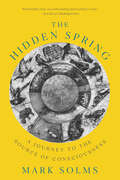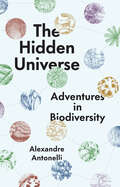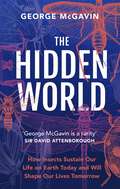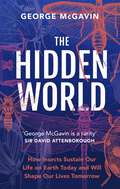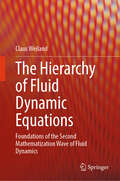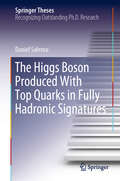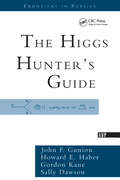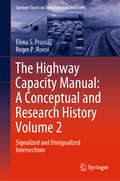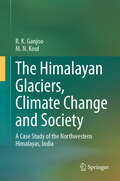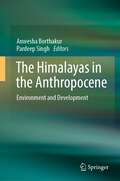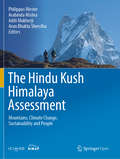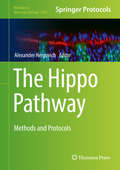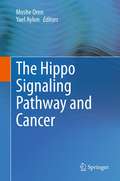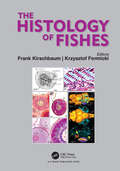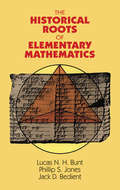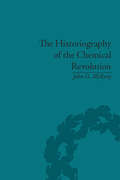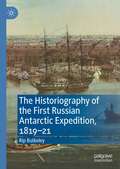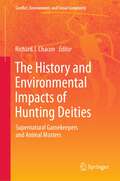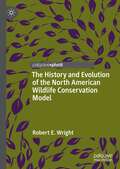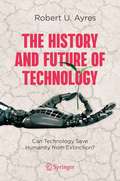- Table View
- List View
The Hidden Spring: A Journey To The Source Of Consciousness
by Mark SolmsA revelatory new theory of consciousness that returns emotions to the center of mental life. For Mark Solms, one of the boldest thinkers in contemporary neuroscience, discovering how consciousness comes about has been a lifetime’s quest. Scientists consider it the "hard problem" because it seems an impossible task to understand why we feel a subjective sense of self and how it arises in the brain. Venturing into the elementary physics of life, Solms has now arrived at an astonishing answer. In The Hidden Spring, he brings forward his discovery in accessible language and graspable analogies. Solms is a frank and fearless guide on an extraordinary voyage from the dawn of neuropsychology and psychoanalysis to the cutting edge of contemporary neuroscience, adhering to the medically provable. But he goes beyond other neuroscientists by paying close attention to the subjective experiences of hundreds of neurological patients, many of whom he treated, whose uncanny conversations expose much about the brain’s obscure reaches. Most importantly, you will be able to recognize the workings of your own mind for what they really are, including every stray thought, pulse of emotion, and shift of attention. The Hidden Spring will profoundly alter your understanding of your own subjective experience.
The Hidden Universe: Adventures in Biodiversity
by Alexandre AntonelliAn unforgettable exploration of the natural world and the concept of biodiversity—what it is, why it matters, and how we as individuals can work to preserve it. We are now living in an environmental emergency. As climate change, habitat loss, and other threats have placed almost one-fifth of all species on Earth at risk of extinction in the coming decades, a deeper understanding of biodiversity has never been more important. Biodiversity encompasses the rich variety of all life on Earth—the building blocks of life that provide invaluable sources of food, medicine, clothing, building materials, and more. Marking the arrival of a bold new voice in popular science, The Hidden Universe shows readers what’s at stake in the fight to protect and restore biodiversity, but also what can and should be done now to protect our planet and ourselves for the future. As director of science at one of the world’s largest research organizations in plant and fungal sciences, Brazilian-born scientist Alexandre Antonelli is ideally suited to reveal the wonders of biodiversity at a genetic, species, and ecosystem level—what biodiversity is, how it works, and why it is the most important tool in our battle against climate change. Antonelli offers recommendations for large-scale political changes, as well as smaller, practical steps that readers can implement in their own lives and homes. With Antonelli as our guide, The Hidden Universe helps us imagine a future where biodiversity is not just preserved but cherished.
The Hidden Universe: Adventures in Biodiversity
by Alexandre AntonelliAn unforgettable exploration of the natural world and the concept of biodiversity—what it is, why it matters, and how we as individuals can work to preserve it. We are now living in an environmental emergency. As climate change, habitat loss, and other threats have placed almost one-fifth of all species on Earth at risk of extinction in the coming decades, a deeper understanding of biodiversity has never been more important. Biodiversity encompasses the rich variety of all life on Earth—the building blocks of life that provide invaluable sources of food, medicine, clothing, building materials, and more. Marking the arrival of a bold new voice in popular science, The Hidden Universe shows readers what’s at stake in the fight to protect and restore biodiversity, but also what can and should be done now to protect our planet and ourselves for the future. As director of science at one of the world’s largest research organizations in plant and fungal sciences, Brazilian-born scientist Alexandre Antonelli is ideally suited to reveal the wonders of biodiversity at a genetic, species, and ecosystem level—what biodiversity is, how it works, and why it is the most important tool in our battle against climate change. Antonelli offers recommendations for large-scale political changes, as well as smaller, practical steps that readers can implement in their own lives and homes. With Antonelli as our guide, The Hidden Universe helps us imagine a future where biodiversity is not just preserved but cherished.
The Hidden World: How Insects Sustain Life on Earth Today and Will Shape Our Lives Tomorrow
by George McGavinInsects conquered the Earth long before we did and will remain here long after we’re gone.They outnumber us in the billions and are essential to many of the natural processes that keep us alive and that we take for granted.Yet, despite this, very few of us know much about the hidden world of insects.In this fascinating new book, entomologist and broadcaster George McGavin takes a deep dive to reveal the unknown truths about the most successful and enduring animal group the world has ever seen, and to show the unseen effects this vast population has on our planet, if only we care to look.McGavin explores not only the incredible traits that insects have evolved to possess, such as dragonflies that can fly across oceans without resting or beetles that lay their eggs exclusively in corpses, but also the vital lessons we have learnt from them, including how therapy using maggots can save lives and how bees can help grow rich tomato yields. The Hidden World reveals the wonderful complexity of our relationship with insects, how they have changed the course of our history and how, if we continue to learn from them, they could even be the key to our future and survival.
The Hidden World: How Insects Sustain Life on Earth Today and Will Shape Our Lives Tomorrow
by George McGavinInsects conquered the Earth long before we did and will remain here long after we’re gone.They outnumber us in the billions and are essential to many of the natural processes that keep us alive and that we take for granted.Yet, despite this, very few of us know much about the hidden world of insects.In this fascinating new book, entomologist and broadcaster George McGavin takes a deep dive to reveal the unknown truths about the most successful and enduring animal group the world has ever seen, and to show the unseen effects this vast population has on our planet, if only we care to look.McGavin explores not only the incredible traits that insects have evolved to possess, such as dragonflies that can fly across oceans without resting or beetles that lay their eggs exclusively in corpses, but also the vital lessons we have learnt from them, including how therapy using maggots can save lives and how bees can help grow rich tomato yields. The Hidden World reveals the wonderful complexity of our relationship with insects, how they have changed the course of our history and how, if we continue to learn from them, they could even be the key to our future and survival.
The Hidden World: How Insects Sustain Life on Earth Today and Will Shape Our Lives Tomorrow
by George McGavinInsects conquered the Earth long before we did and will remain here long after we're gone.They outnumber us in the billions and are essential to many of the natural processes that keep us alive and that we take for granted.Yet, despite this, very few of us know much about the hidden world of insects.In this fascinating new book, entomologist and broadcaster George McGavin takes a deep dive to reveal the unknown truths about the most successful and enduring animal group the world has ever seen, and to show the unseen effects this vast population has on our planet, if only we care to look.McGavin explores not only the incredible traits that insects have evolved to possess, such as dragonflies that can fly across oceans without resting or beetles that lay their eggs exclusively in corpses, but also the vital lessons we have learnt from them, including how therapy using maggots can save lives and how bees can help grow rich tomato yields.The Hidden World reveals the wonderful complexity of our relationship with insects, how they have changed the course of our history and how, if we continue to learn from them, they could even be the key to our future and survival.
The Hierarchy of Fluid Dynamic Equations: Foundations of the Second Mathematization Wave of Fluid Dynamics
by Claus WeilandThis book is devoted to the most general governing equations of the fluid mechanics, namely the Navier-Stokes equations and their derivatives. These equations are presented in various manners: for several coordinate systems, for laminar and turbulent flows, for different thermodynamic states of gases, in dimensional and non-dimensional forms, and in an incompressible situation. All that is valid also for the different versions of the Navier-Stokes equations, where appropriate. The only way to solve the fluid dynamic equations for complex three-dimensional problems consists in the use of numerical integration methods. To deal with this request it is very helpful to formulate the complete set of governing equations in vector or vector-matrix form. This is true also for two equations turbulence models as well as for the description of non-equilibrium effects of thermodynamics. These requirements are fully addressed in this book. Graduate and doctoral students, who are concerned with the numerical solutions of the fluid dynamic equations for specific problems, may find in this book the suggestions regarding the degree of approximation which could be adequate for the task they consider. Further, persons who are interested in the evolution of the mathematical description of fluid dynamic issues, both from the scientific and also the historical side, may discover suggestions, advices and motivations in this book.
The Higgs Boson Discovery at the Large Hadron Collider
by Roger WolfThis book provides a comprehensive overview of the field of Higgs boson physics. It offers the first in-depth review of the complete results in connection with the discovery of the Higgs boson at CERN's Large Hadron Collider and based on the full dataset for the years 2011 to 2012. The fundamental concepts and principles of Higgs physics are introduced and the important searches prior to the advent of the Large Hadron Collider are briefly summarized. Lastly, the discovery and first mensuration of the observed particle in the course of the CMS experiment are discussed in detail and compared to the results obtained in the ATLAS experiment.
The Higgs Boson Produced With Top Quarks in Fully Hadronic Signatures (Springer Theses)
by Daniel SalernoThe work presented in this PhD dissertation is the first search at CMS for Higgs bosons produced in association with top quarks (ttH) in a final state consisting of only jets. The results presented in this book uncover a new class of ttH events that will help us elucidate our understanding of the Yukawa sector interactions between the Higgs boson and the top quark. Despite this being the most common decay signature for ttH, a large contamination of SM backgrounds makes it the most challenging for extracting a signal from data. The PhD thesis presents many sophisticated tools and techniques that were developed in order to overcome these challenges. These tools pave the way for future analyses to investigate other standard model and beyond-standard model physics.
The Higgs Hunter's Guide (Frontiers in Physics)
by John F. GunionThe Higgs Hunter's Guide is a definitive and comprehensive guide to the physics of Higgs bosons. In particular, it discusses the extended Higgs sectors required by those recent theoretical approaches that go beyond the Standard Model, including supersymmetry and superstring-inspired models.
The High-Mountain Cryosphere
by John J. Clague Huggel, Christian and Carey, Mark and Clague, John J. and Kääb, Andreas Christian Huggel Mark Carey Andreas KääbThis edited volume, showcasing cutting-edge research, addresses two primary questions - what are the main drivers of change in high-mountains and what are the risks implied by these changes? From a physical perspective, it examines the complex interplay between climate and the high-mountain cryosphere, with further chapters covering tectonics, volcano-ice interactions, hydrology, slope stability, erosion, ecosystems, and glacier- and snow-related hazards. Societal dimensions, both global and local, of high-mountain cryospheric change are also explored. The book offers unique perspectives on high-mountain cultures, livelihoods, governance and natural resources management, focusing on how global change influences societies and how people respond to climate-induced cryospheric changes. An invaluable reference for researchers and professionals in cryospheric science, geomorphology, climatology, environmental studies and human geography, this volume will also be of interest to practitioners working in global change and risk, including NGOs and policy advisors.
The Highbush Blueberry and Its Management
by Robert E GoughHere is a book that sets forth vital information growers need to produce highbush blueberries effectively and efficiently. Written from the grower?s point of view, The Highbush Blueberry and Its Management presents technical information in a highly readable manner that is easy to understand. It helps growers make proper decisions before they plant-
The Highway Capacity Manual: Signalized and Unsignalized Intersections (Springer Tracts on Transportation and Traffic #12)
by Elena S. Prassas Roger P. RoessSince 1950, the Highway Capacity Manual has been a standard used in the planning, design, analysis, and operation of virtually any highway traffic facility in the United States. It has also been widely used around the globe and has inspired the development of similar manuals in other countries. This book is Volume II of a series on the conceptual and research origins of the methodologies found in the Highway Capacity Manual. It focuses on the most complex points in a traffic system: signalized and unsignalized intersections, and the concepts and methodologies developed over the years to model their operations. It also includes an overview of the fundamental concepts of capacity and level of service, particularly as applied to intersections. The historical roots of the manual and its contents are important to understanding current methodologies, and improving them in the future. As such, this book is a valuable resource for current and future users of the Highway Capacity Manual, as well as researchers and developers involved in advancing the state-of-the-art in the field.
The Himalayan Glaciers, Climate Change and Society: A Case Study of the Northwestern Himalayas, India
by R. K. Ganjoo M. N. KoulThis book provides detailed information on the Northwestern Himalayas in India. The scientific data compiled in the book is based on more than two decades of field and laboratory studies by the authors. The Ladakh region is a well-known cold desert with unique geological and climatic setting. The influence of Westerlies in the region has played significant role in the Ladakh region to behave much differently than rest of the Himalaya. The “Karakorum Anomaly” has been a key factor in negating the effect of global climate change in this region of Himalaya. The scientific discussion of some major glaciers of the region, as case study, are also discussed in this book. The uniqueness of the region with respect to climate shall be elaborated with the help of case studies.
The Himalayas in the Anthropocene: Environment and Development
by Pardeep Singh Anwesha BorthakurThis book aims to provide a comprehensive overview of the current challenges in one of the most biodiverse regions in the world. Environmental sustainability and climate change implications in the mountain ecosystems in general and mountainous regions of the Global South in particular are key concerns of the present-day world. In particular, the mountainous regions in the Global South are excessively being subjected to haphazard developmental activities making them vulnerable to all possible aspects of climate change. Ecologically fragile and biodiversity-rich (considered ‘hotspot’ of biodiversity) Himalayan Region (HR) is subjected to high vulnerability due to climate change and unsustainable developmental activities. A major portion of the Indian HR, for instance, has gradually been endangered by intense environmental burden owing to rapid and haphazard urbanization, extreme weather events, etc. Unfortunately, environmental sustainability studies in many parts of the region are still inadequate. Accordingly, in this book, the authors provide a detailed account of the Himalayas in the epoch of Anthropocene—“the most recent period in Earth’s history when human activity started to have a significant impact on the planet’s climate and ecosystems" (as defined by the National Geographic Society). It is no secret that the haphazard developmental activities in the Himalayas are having tremendous impacts on the local ecosystems. Many of such impacts are irreversible over the next hundreds of years and it should ring an alarm to all of us alike. Therefore, it becomes increasingly imperative that we document the existing anthropogenic challenges in the Himalayas, analyse them and find a way where environment and development can go hand in hand. This book is an attempt in that direction. The authors aim to address issues ranging from unorganized tourism practices to the big dams in the Himalayas and from mining and quarrying activities to climate change implications and sustainable development goals (SDGs).
The Hindu Kush Himalaya Assessment: Mountains, Climate Change, Sustainability and People
by Philippus Wester Arabinda Mishra Aditi Mukherji Arun Bhakta ShresthaThis open access volume is the first comprehensive assessment of the Hindu Kush Himalaya (HKH) region. It comprises important scientific research on the social, economic, and environmental pillars of sustainable mountain development and will serve as a basis for evidence-based decision-making to safeguard the environment and advance people’s well-being. The compiled content is based on the collective knowledge of over 300 leading researchers, experts and policymakers, brought together by the Hindu Kush Himalayan Monitoring and Assessment Programme (HIMAP) under the coordination of the International Centre for Integrated Mountain Development (ICIMOD). This assessment was conducted between 2013 and 2017 as the first of a series of monitoring and assessment reports, under the guidance of the HIMAP Steering Committee: Eklabya Sharma (ICIMOD), Atiq Raman (Bangladesh), Yuba Raj Khatiwada (Nepal), Linxiu Zhang (China), Surendra Pratap Singh (India), Tandong Yao (China) and David Molden (ICIMOD and Chair of the HIMAP SC).This First HKH Assessment Report consists of 16 chapters, which comprehensively assess the current state of knowledge of the HKH region, increase the understanding of various drivers of change and their impacts, address critical data gaps and develop a set of evidence-based and actionable policy solutions and recommendations. These are linked to nine mountain priorities for the mountains and people of the HKH consistent with the Sustainable Development Goals. This book is a must-read for policy makers, academics and students interested in this important region and an essentially important resource for contributors to global assessments such as the IPCC reports.
The Hippo Pathway: Methods And Protocols (Methods in Molecular Biology #1893)
by Alexander HergovichThis detailed book covers numerous expert methodologies to examine Hippo signaling on the structural, molecular, cellular, and organismal level. Beginning with a section on Drosophila genetics, the volume continues with parts exploring molecular and cell biological studies of the Hippo pathway, the use of structural biology and biochemistry, and a brief look at the Hippo pathway in mouse models. Written for the highly successful Methods in Molecular Biology series, chapters contain introductions to their respective topics, lists of the necessary materials and reagents, step-by-step, readily reproducible laboratory protocols, and tips on troubleshooting and avoiding known pitfalls. Comprehensive and practical, The Hippo Pathway: Methods and Protocols equips newcomers and specialists alike with key methodologies to accurately define the status of Hippo signaling in their experimental settings.
The Hippo Signaling Pathway and Cancer
by Moshe Oren Yael AylonThe Hippo signaling pathway is rapidly gaining recognition as an important player in organ size control and tumorigenesis, and many leading scientists are showing increased interest in this growing field and it's relation to cancer. For instance, for the past two years, over 60 researchers from all over the world, have gathered annually for an intensive "Hippo Pathway Workshop" in Rome, Italy. This year, the workshop has been sponsored by Keystone Symposium and will be held in Monterey, California in Spring, 2013.This confirms the growing interest for the Hippo field within the international scientific community. The prospective list of the chapters covers virtually all aspects of tumor biology. This is because members of the Hippo Pathway have been associated with numerous well-established cell signaling pathways, just to name a few; Ras, Wnt, TGFbeta and p53. Moreover, Hippo signaling is not solely involved in regulating "classic" tumor characteristics such as cell proliferation, survival and growth, but is also diversely involved in cell-autonomous and non-cell-autonomous differentiation, migration and organ size control. The primary audience are researchers interested in basic science in the areas of tumor suppression, cell cycle and size regulation, development and differentiation.
The Histology of Fishes
by Frank Kirschbaum Krzysztof FormickiThe book is a multi-authored book of 18 chapters comprising the state of the art work of all relevant topics on modern fish histology from 28 authors from ten countries. The topics include Introduction to Histological Techniques, Integument, Fish Skeletal Tissues, Muscular System, Structure and Function of Electric Organs, Digestive System, Glands of the Digestive Tract, Swim Bladder, Kidney, Ovaries and Eggs, Egg Envelopes, Testis Structure, Spermatogenesis, and Spermatozoa in Teleost Fishes, Cardiovascular System and Blood, Immune System of Fish, Gills: Respiration and Ionic-Osmoregulation, Sensory Organs, Morphology and Ecomorphology of the Fish Brain, and Endocrine System. Structural and functional aspects are treated and in a comparative way fish diversity at various taxonomic levels is integrated.
The Historical Roots of Elementary Mathematics
by Lucas N. Bunt Jack D. Bedient Phillip S. Jones"Will delight a broad spectrum of readers." -- American Mathematical MonthlyDo long division as the ancient Egyptians did! Solve quadratic equations like the Babylonians! Study geometry just as students did in Euclid's day! This unique text offers students of mathematics an exciting and enjoyable approach to geometry and number systems. Written in a fresh and thoroughly diverting style, the text -- while designed chiefly for classroom use -- will appeal to anyone curious about mathematical inscriptions on Egyptian papyri, Babylonian cuneiform tablets, and other ancient records.The authors have produced an illuminated volume that traces the history of mathematics -- beginning with the Egyptians and ending with abstract foundations laid at the end of the 19th century. By focusing on the actual operations and processes outlined in the text, students become involved in the same problems and situations that once confronted the ancient pioneers of mathematics. The text encourages readers to carry out fundamental algebraic and geometric operations used by the Egyptians and Babylonians, to examine the roots of Greek mathematics and philosophy, and to tackle still-famous problems such as squaring the circle and various trisectorizations.Unique in its detailed discussion of these topics, this book is sure to be welcomed by a broad range of interested readers. The subject matter is suitable for prospective elementary and secondary school teachers, as enrichment material for high school students, and for enlightening the general reader. No specialized or advanced background beyond high school mathematics is required.
The Historiography of the Chemical Revolution: Patterns of Interpretation in the History of Science
by John G McEvoyThis study offers a critical survey of past and present interpretations of the Chemical Revolution designed to lend clarity and direction to the current ferment of views.
The Historiography of the First Russian Antarctic Expedition, 1819–21
by Rip BulkeleyThis book looks at the different ways in which Russian historians and authors have thought about their country’s first Antarctic expedition (1819-21) over the past 200 years. It considers the effects their discussions have had on Russia’s Antarctic policy and may yet have on Antarctica itself. In particular, it examines the Soviet decision in 1949, in line with the cultural policies of late Stalinism, to revise the traditional view of the expedition in order to claim that it was Russian seamen that first sighted the Antarctic mainland in January 1820; this claim remains the official position in Russia today. The author illustrates, however, that the case for such a claim has never been established, and that attempts to make it damaged the work of successive Russian historians. Providing a timely assessment of Russian historiography of the Bellingshausen expedition and examining the connections between the priority claim and national policy goals, this book represents an important contribution to the history of the Antarctic.
The History and Environmental Impacts of Hunting Deities: Supernatural Gamekeepers and Animal Masters (Conflict, Environment, and Social Complexity)
by Richard J. ChaconThis edited volume analyzes the belief in supernatural gamekeepers and/or animal masters of wildlife from a cross-cultural perspective. It documents the antiquity and widespread occurrence of the belief in supernatural gamekeepers at the global level. This interdisciplinary volume documents both the antiquity and the widespread geographical distribution of this belief along with surveying the various manifestations of this cosmology by way of studies from Europe, Asia, Africa, and North and South America. Some chapters explore the manifestations of this belief as they appear in petroglyphs/pictographs and other forms of material culture. Others focus on the environmental impacts of these beliefs/rituals and prescribed foraging restrictions by analyzing how they affect game harvests. The internationally recognized scholars in this volume assess the efficacy of this particular form of traditional ecological knowledge (TEK) and investigate if adherence to the belief in animal masters actually causes hunters to refrain from overharvesting wild game and thereby contributes to sustainable hunting practices. This volume is of interest to anthropologists, archaeologists and other social scientists researching traditional ecological knowledge (TEK), indigenous conservation, biodiversity, and sustainability practices, and animal deities.
The History and Evolution of the North American Wildlife Conservation Model
by Robert E. WrightThis book explains how six policies collectively called the North American Wildlife Conservation Model (NAWCM), put in place around the turn of the twentieth century, saved numerous iconic big game species from extinction. Rigid adherence to the NAWCM, however, especially its ban on the commercial sale of wild game meat, has allowed deer and some other species to become overabundant pests in areas where hunting pressure recently declined and habitat rebounded. Texas and South Africa have proven that scientific insight and market incentives can combine to prevent game overabundance and decrease the fragility and extend the range of iconic mammal game species. This book outlines how intermediate steps, like proxy hunting and other wildlife regulation reforms, could be used to lure more hunters into the field and move other states towards the Texas model incrementally, thereby minimizing risks to wildlife or human stakeholders.
The History and Future of Technology: Can Technology Save Humanity from Extinction?
by Robert U. AyresEminent physicist and economist, Robert Ayres, examines the history of technology as a change agent in society, focusing on societal roots rather than technology as an autonomous, self-perpetuating phenomenon. With rare exceptions, technology is developed in response to societal needs that have evolutionary roots and causes. In our genus Homo, language evolved in response to a need for our ancestors to communicate, both in the moment, and to posterity. A band of hunters had no chance in competition with predators that were larger and faster without this type of organization, which eventually gave birth to writing and music. The steam engine did not leap fully formed from the brain of James Watt. It evolved from a need to pump water out of coal mines, driven by a need to burn coal instead of firewood, in turn due to deforestation. Later, the steam engine made machines and mechanization possible. Even quite simple machines increased human productivity by a factor of hundreds, if not thousands. That was the Industrial Revolution. If we count electricity and the automobile as a second industrial revolution, and the digital computer as the beginning of a third, the world is now on the cusp of a fourth revolution led by microbiology. These industrial revolutions have benefited many in the short term, but devastated the Earth’s ecosystems. Can technology save the human race from the catastrophic consequences of its past success? That is the question this book will try to answer.
